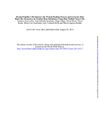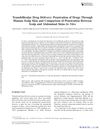TLDR Porcine skin varies by region, affecting its use as a human skin model.
The study evaluated the histological structure of porcine skin from 11 different anatomic regions in the American Yorkshire crossbreed, focusing on epidermal and dermal thickness, hair follicle density, and collagen and elastin composition and distribution. Significant regional differences were found, particularly in dermis and epidermis thickness and collagen and elastin content. Variations in type I and type III collagen distribution were also observed. These findings underscored the importance of recognizing regional differences in porcine skin to prevent misinterpretation when using it as a model for human skin.
 68 citations
,
August 2014 in “Stem Cells Translational Medicine”
68 citations
,
August 2014 in “Stem Cells Translational Medicine” Dermal papilla cells help wounds heal better and can potentially grow new hair.
 43 citations
,
July 2014 in “Experimental Dermatology”
43 citations
,
July 2014 in “Experimental Dermatology” Hair follicles can help wounds heal faster and this knowledge could be used to treat chronic skin ulcers, with a potential use of a special stem cell hydrogel to enhance healing.
405 citations
,
January 2004 in “Journal of Investigative Dermatology” Hair follicle size and distribution vary significantly across different body sites.
 82 citations
,
January 2002 in “Journal of drug targeting”
82 citations
,
January 2002 in “Journal of drug targeting” Drugs penetrate scalp skin better than abdominal skin, with scalp hair follicles aiding in higher drug delivery.
 November 2022 in “The journal of investigative dermatology/Journal of investigative dermatology”
November 2022 in “The journal of investigative dermatology/Journal of investigative dermatology” YAP1 is important for skin regeneration and may affect skin disorder treatments.
 84 citations
,
January 2018 in “Biomaterials Science”
84 citations
,
January 2018 in “Biomaterials Science” Sericin hydrogels heal skin wounds well, regrowing hair and glands with less scarring.
44 citations
,
November 2014 in “Tissue Engineering Part C Methods” Porcine skin varies by region, affecting its use as a human skin model.
January 2006 in “Journal of Sun Yat-sen University” Engineered skin using stem cells and collagen sponge effectively healed and regenerated complex skin features in mice.





